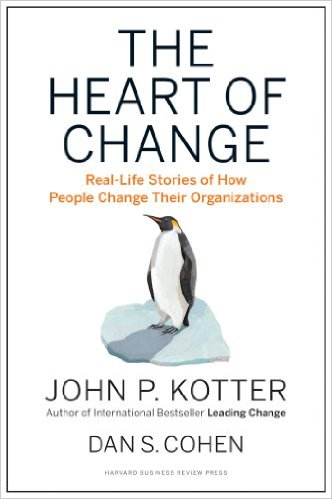The Heart of Change

You would think that with the great value I saw in John Kotter’s Leading Change book I would have jumped to read The Heart of Change – but I didn’t. Part of that may be the fact that I’ve had a pretty deep reading list for a while. Part of it may have been that I felt like I had extracted the most valuable piece from Kotter’s work – the process. No matter what the reason, more time spent with the change model was well worth it.
More than any other of the books that I read lately, I found myself taking notes about The Heart of Change. I was writing in the virtual margins on my Acer Iconia A500 Tablet with the Kindle software. I kept reading and writing notes and parallels.
I wrote in one spot the classic (if not potentially insensitive) question: How do you eat an elephant? The answer is simple and surprising. One bite at a time. In another place I wrote “You can’t boil the ocean.” These clichés may be overused but they represent a fundamental awareness that Kotter and his co-author Dan Cohen grok.
Distilling the key message of the book into just this would be an over simplification, but core to the book is the idea that first people SEE the need to change, then they FEEL the need to change, and then, with luck, they CHANGE. This SEE-FEEL-CHANGE model is important. If I put this into the language of The Happiness Hypothesis and Switch it’s about the elephant, the rider, and the path. The rider must become aware of the change that’s needed (urgently), but it’s the elephant, the emotional powerhouse of the arrangement, that must FEEL the need to change. With a bit of luck in shaping the path (removing barriers) change can occur.
It seems that the natural resistance to change – which is less about resistance and more about confusion – can be overcome by feelings. The elephant will start to move when he senses that standing still isn’t working.
| Another interesting thought that swept across me while reading The Heart of Change was the idea of a fish ladder. If you don’t know what these are, they are specifically designed parts of a waterway that are designed to allow fish to traverse dams, locks, and other manmade structures that have disrupted their normal migration. What’s remarkable about these fish ladders is that they aren’t so much a set of distinct areas but rather a connected system. As the water flows across them they make each individual step – which are distinct in structure – seem like a part of a system. So there’s a bit of overlap – or connectedness – between the steps. The Heart of Change speaks to this exact thing – that the steps aren’t so distinct as they are a natural system where the lines blur and the next step starts before the previous one ends. Sidebar: the whole idea of a fish on a ladder is funny if you think about it. How do the fish hold on to the rungs?
I was also struck by a story about how pictures were removed from the lobby of one organization – not because changing the décor is the solution to changing a company – rather – I was struck by how sometimes simple, stupid, unseen things are the sacred cows of the organization. They’re the thing, process, or procedure with the unwritten “do not touch” rule. My note on the story was “find the sacred cows and slay them – with theatrical style.” Why would I write such a thing? It’s simple. There are far too many sacred cows, it’s time to thin the herd. Make sure the sacred cows that remain are meaningful. |
 Image from Flicker – USFWS Pacific Image from Flicker – USFWS Pacific |
A quote from the book is “You can’t plan what you don’t understand.” The context is that it’s difficult to plan for radical changes because you don’t understand what a radical change will look like. However, it occurred to me that this extends beyond. The great project managers I’ve worked with always seek to understand. They want to know how things work – even if they don’t understand the details, a foundational understanding makes them better at planning the project. It also occurred to me that far too often organizations try to move forward through a transformation without an understanding of what the other side looks like.
Even after all the books I’ve read on change, on thinking, or motivating, I still found new ways of connecting to this content. If you’re trying to figure out how to do change, pick up The Heart of change
